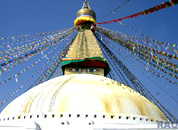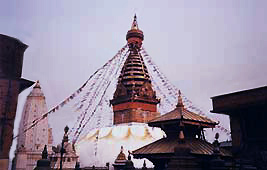|
Balmiki
Ashram
The
Balmiki Ashram was a retreat site used by the great Hindu sage Balmiki.
This is where Sita came to live with her two sons Labha and Kusha after
separating from Rama. Various statues were unearthed in the area during
an archaeological excavation in late 60s. The Ashram is situated in a forest
on the bank of the Tribeni river, at the south-western corner of the Chitwan
National Park. It can be reached by boat.
Bauddha
(Bodhnath / Boudhanath)
 |
Is
about 1 km east of Chabahil on the road to Sundarijal or Sakhu. The Bodhnath
Stupa is 38 m high and 100 m in circumference. It is the largest stupa
in Nepal and is revered by both Tibetan and Newar Buddhists. |
 |
|
|
 |
|
All the major
festivals are fixed according to lunar patterns: Mamla Jatra (January/February),
Losar (usually in February), Timal Jatra (March/April), Gonai (July/August)
Barah
Chhetra
Is
one of the great Hindu pilgrimage centres, where Sarah the boar incarnation
of Lord Vishnu, protector of the universe, fought with the demon Hiranakshya
and killed him. Apart from the main shrine dedicated to Barah, there are
many other temples that bear the image of Bishnu's boar incarnation.
It is located at the confluence of the mighty Sapta Koshi and Koka Rivers,
a few kilometres from the industrial town of Biratnagar in east Nepal.
A religious fair takes place here in November.
Devghat
Is
where the Trisuli and the Kali Gandaki rivers confluence to form the Narayani,
a major tributary of the Ganga. Confluences of major rivers such as these
are considered very holy. It is situated 6 km to the north of Bharatpur,
the gateway to the Chitwan National Park, where hotels are available. There
are daily flights and bus services from Kathmandu. On the day of the Makar
Sankranti (winter solstice) festival in January, pilgrims converge here
to take holy dips.
Manakamana
The
temple of Manakamana is perched on a hill 1,302-m high. The deity is one
of the manifestations of the Hindu Goddess Bhagwati who is believed to
have the power to fulfil wishes. It is one of the most popular pilgrimage
sites in Nepal. It is situated 125 km to the west of Kathmandu. It
is a steep three -hour hike to the hilltop from Abu Khaireni on the Kathmandu
-Gorkha highway. Or you can take the Cable car at Cheres, 104 km from Kathmandu
on the highway to Pokhara. Package tours are available, and you can be
back the same day. There are hotels at Manakamana if you want to stay the
night.
Muktinath
Is
revered as sacred by both Hindus and Buddhists. The main shrine is a pagoda-
shaped temple dedicated to Lord Bishnu. Set into the wall around it are
108 waterspouts from which pour holy water. The Jwala Mai temple nearby
contains a spring and an eternal flame fed by natural gas spewing out of
the ground. Muktinath (altitude 3,800 m) is situated in north central Nepal
on the northern arc of the Annapurna Circuit trekking trail. It is a six
hour walk from Jomsom airport (2,713 m). Helicopter services are also available.
There are pilgrim rest houses, lodges and restaurants at Ranipauwa nearby.
Ridi
Is
second only to the Pashupatinath temple in Kathmandu in holiness. The Rikheswar
Narayan Mandir situated here is the local version of the Pashupatinath
temple with its auspicious cremation ghats. It is situated at the confluence
of two rivers the kali Gandaki and the Ridi Khola in mid-west Nepal. Devotees
from Nepal as well as from India were brought here on Makar Sankranti for
a ritual dip in the water. A 50 km dirt road links Ridi with the hill resort
town of Tansen, where accommodation is available.

|
more religious
sites in
the Kathmandu Valley
|
|





